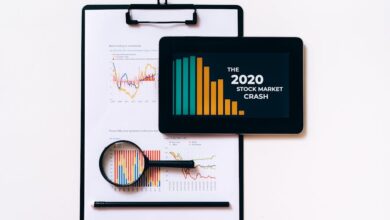Weathering the Economic Storm: Understanding Recession Signs, Investment Strategies, and Business Resilience

In an unpredictable economic landscape, understanding the nuances of recessions is crucial for individuals, businesses, and policymakers alike. As economies experience fluctuations, early warning signs of a downturn can often go unnoticed until it’s too late. This article delves into the multifaceted nature of recessions, exploring the early indicators that signal impending economic challenges and the profound impacts these downturns have across various sectors. We will examine effective investment strategies that can help mitigate risks during turbulent times, as well as the critical role of government stimulus in cushioning the blow of economic contractions. Additionally, we'll investigate how consumer behavior shifts in response to financial uncertainty and the repercussions for global trade and supply chains. Drawing lessons from past recessions, we aim to equip readers with insights on how businesses can not only weather the storm but emerge stronger. Join us as we navigate these essential topics, providing a comprehensive guide to understanding and preparing for economic downturns.
- 1. Recognizing the Red Flags: Early Warning Signs of an Economic Recession
- 2. Navigating the Storm: Investing Strategies for Economic Downturns
- 3. Resilience in Crisis: How Businesses Can Prepare for and Survive a Recession
1. Recognizing the Red Flags: Early Warning Signs of an Economic Recession
Recognizing early warning signs of an economic recession is crucial for individuals, businesses, and policymakers to take proactive measures. Several indicators can signal a downturn before it becomes evident in broader economic metrics.
One of the primary signs is a decline in consumer confidence. When consumers feel uncertain about their financial stability or the economy's direction, they tend to reduce spending, which can lead to decreased demand for goods and services. This shift often results in lower sales for businesses, prompting them to cut back on production and hiring.
Another significant indicator is a rise in unemployment rates. As companies begin to anticipate a downturn, they may implement layoffs or hiring freezes, leading to increased joblessness. This, in turn, reduces disposable income and consumer spending, further exacerbating economic challenges.
Additionally, changes in the stock market can provide insight into future economic performance. A sustained drop in stock prices often reflects investors' pessimism about corporate profits and economic growth. This sentiment can lead to a reduction in investment and spending by businesses, contributing to a cyclical downturn.
Leading economic indicators, such as the Purchasing Managers' Index (PMI) and retail sales figures, also serve as red flags. A decline in the PMI indicates reduced manufacturing activity, while falling retail sales signal weaker consumer demand. Both trends can foreshadow a recession.
Finally, shifts in monetary policy, such as rising interest rates by central banks, can indicate an attempt to control inflation but may inadvertently slow economic growth. Higher borrowing costs can lead businesses and consumers to cut back on spending, further signaling an impending recession.
By recognizing these early warning signs, stakeholders can better prepare for economic downturns and mitigate their impacts.
2. Navigating the Storm: Investing Strategies for Economic Downturns
Investing during an economic downturn requires a strategic approach that emphasizes preservation of capital while seeking opportunities for growth. One key strategy is to shift focus towards defensive stocks, which tend to perform better during recessions. These include companies in sectors such as utilities, healthcare, and consumer staples, as their products and services remain in demand regardless of economic conditions.
Another effective strategy is to consider dividend-paying stocks. Companies with a history of stable or increasing dividends can provide a reliable income stream, even when share prices may be volatile. Additionally, bonds, particularly government bonds, can serve as a safer investment during downturns, offering fixed interest payments that can help mitigate losses from equity investments.
Investors might also look into diversification across asset classes. This can include a mix of equities, fixed income, and alternative investments such as real estate or commodities. Diversification helps reduce risk by spreading investments across different sectors and geographies, which can cushion against the impacts of a recession on any single sector.
Moreover, maintaining a cash reserve can provide flexibility and the opportunity to take advantage of lower asset prices. During downturns, many investors panic and sell at a loss; however, those with liquidity can capitalize on discounted investments, positioning themselves for recovery when the economy rebounds.
Finally, considering a long-term perspective is crucial. While market volatility can be unsettling, history shows that economies do recover over time. Investors who remain committed to their long-term strategies, rather than reacting impulsively to short-term market fluctuations, are often better positioned to achieve their financial goals. By focusing on these strategies, investors can navigate the storm of an economic downturn more effectively.
3. Resilience in Crisis: How Businesses Can Prepare for and Survive a Recession
In times of economic uncertainty, resilience becomes a critical trait for businesses aspiring to not only survive but thrive during a recession. Preparing for such downturns involves a multifaceted approach that encompasses financial prudence, operational flexibility, and strategic foresight.
First and foremost, businesses should maintain a robust financial foundation. This includes building an emergency fund, reducing debt, and ensuring liquidity to cover essential expenses during lean periods. Companies that prioritize cash flow management can better navigate the challenges of declining revenues. Additionally, diversifying revenue streams can mitigate the risks associated with dependence on a single product or market.
Operational flexibility is also vital. Businesses should regularly assess and adapt their operations to remain agile in response to shifting market conditions. This may involve streamlining processes, investing in technology to enhance efficiency, or adjusting inventory levels to avoid overstocking. Flexible workforce strategies, such as cross-training employees and utilizing temporary staffing solutions, can help businesses respond swiftly to changes in demand.
Moreover, effective communication and strong relationships with stakeholders, including employees, customers, and suppliers, are crucial during a recession. Transparent communication can foster trust and loyalty, which are especially important when consumer confidence is low. Engaging customers through personalized marketing and maintaining high-quality service can help retain existing clients while attracting new ones.
Finally, businesses should leverage historical insights and economic data to inform their strategic decisions. By analyzing past recessions, companies can identify patterns and adopt best practices that have proven effective in crisis situations. This proactive approach to risk management not only prepares businesses for potential downturns but also positions them to capitalize on opportunities that may arise as the economy recovers.
In summary, resilience in crisis hinges on financial preparedness, operational agility, stakeholder engagement, and informed decision-making. By embracing these strategies, businesses can navigate the complexities of a recession and emerge stronger on the other side.
In conclusion, understanding the complex dynamics of economic recessions is crucial for individuals, businesses, and policymakers alike. By recognizing early warning signs, such as declining consumer confidence and rising unemployment rates, stakeholders can better anticipate downturns and take proactive measures. Investing strategies tailored to recessionary environments can help safeguard assets, while businesses equipped with resilience strategies can navigate the challenges posed by economic contraction.
Moreover, the role of government stimulus cannot be understated; timely interventions can alleviate the adverse effects on both consumers and industries, sustaining economic stability. As consumer behavior shifts during downturns, businesses must adapt their strategies to meet changing demands and maintain competitiveness.
The lessons learned from past recessions offer valuable insights into current economic conditions, emphasizing the importance of preparedness and adaptability. By fostering a culture of resilience and strategic foresight, organizations can not only survive but potentially thrive in the face of economic uncertainty. Ultimately, a collective understanding of these factors will empower stakeholders to navigate future challenges with greater confidence and effectiveness.





